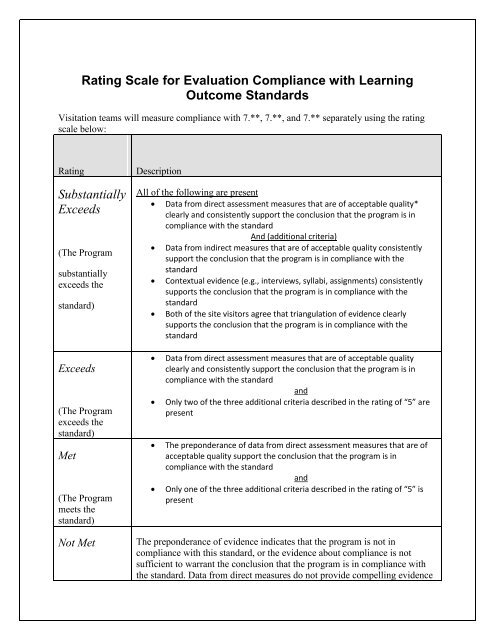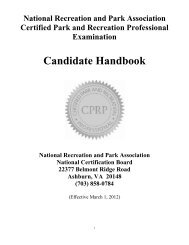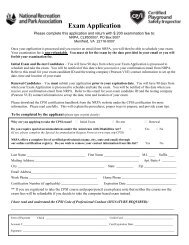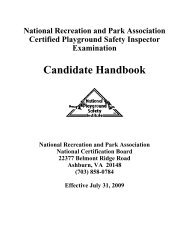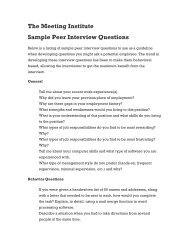Rating Scale for Evaluation Compliance with Learning Outcome ...
Rating Scale for Evaluation Compliance with Learning Outcome ...
Rating Scale for Evaluation Compliance with Learning Outcome ...
You also want an ePaper? Increase the reach of your titles
YUMPU automatically turns print PDFs into web optimized ePapers that Google loves.
<strong>Rating</strong> <strong>Scale</strong> <strong>for</strong> <strong>Evaluation</strong> <strong>Compliance</strong> <strong>with</strong> <strong>Learning</strong><strong>Outcome</strong> StandardsVisitation teams will measure compliance <strong>with</strong> 7.**, 7.**, and 7.** separately using the ratingscale below:<strong>Rating</strong>SubstantiallyExceeds(The Programsubstantiallyexceeds thestandard)DescriptionAll of the following are present Data from direct assessment measures that are of acceptable quality*clearly and consistently support the conclusion that the program is incompliance <strong>with</strong> the standardAnd (additional criteria) Data from indirect measures that are of acceptable quality consistentlysupport the conclusion that the program is in compliance <strong>with</strong> thestandard Contextual evidence (e.g., interviews, syllabi, assignments) consistentlysupports the conclusion that the program is in compliance <strong>with</strong> thestandard Both of the site visitors agree that triangulation of evidence clearlysupports the conclusion that the program is in compliance <strong>with</strong> thestandardExceeds(The Programexceeds thestandard)Met(The Programmeets thestandard)Data from direct assessment measures that are of acceptable qualityclearly and consistently support the conclusion that the program is incompliance <strong>with</strong> the standardandOnly two of the three additional criteria described in the rating of “5” arepresentThe preponderance of data from direct assessment measures that are ofacceptable quality support the conclusion that the program is incompliance <strong>with</strong> the standardandOnly one of the three additional criteria described in the rating of “5” ispresentNot MetThe preponderance of evidence indicates that the program is not incompliance <strong>with</strong> this standard, or the evidence about compliance is notsufficient to warrant the conclusion that the program is in compliance <strong>with</strong>the standard. Data from direct measures do not provide compelling evidence
(The Programdoes not meet thestandardof compliance. Some indirect measures may indicate compliance.)SeriousnoncomplianceSources of evidence clearly and consistently indicate that the program is notin compliance <strong>with</strong> this standard(The program isseriously out ofcompliance <strong>with</strong>the standard*”Acceptable quality” means that content-related evidence of validity is present. More <strong>for</strong>mally,a measurement tool (“metric”) is of acceptable quality if inferences made about students’achievement of learning outcomes based on scores from the measurement tools are justifiable.Site visitors should consider content-relevance and content-representativeness in makingjudgments about content-related evidence of validity. As such, the metrics should a) includequality indicators of the relevant dimensions of the learning outcome being measured (contentrelevance), and b) be representative of the major facets of the learning outcome that is the targetof the measurement.A simple example is a test of comprehensive elementary arithmetic skill that might beadministered to grade-school children. Such a test should present arithmetic problems from allfour dimensions of arithmetic: addition, subtraction, multiplication, and division. If one of thesedimensions was not assessed (e.g., no division problems were included on the test), the testwould lack content representativeness. In this case, it would not be justifiable to make aninference about students’ comprehensive arithmetic skills if the test lacked items from one ormore of the four dimensions of arithmetic. That test did not generate evidence of skill in one ofthe essential four dimensions. Similarly, if the items on the test were statements about students’attitudes about mathematics instead of being arithmetic problems to be solved, the test wouldlack content relevance. That test might (or might not) be an acceptable measure of attitudetoward arithmetic, but it would not be justifiable to make an inference about a given student’sarithmetic skill based on responses to these attitudinal questions.In the context of COA assessment, indicators should, in the site visitor’s judgment, be contentrelevantand content-representative. A measure of operations management skill (whether it be awritten exam, direct measure of per<strong>for</strong>mance, or other measure) would lack contentrepresentativenessif that test was limited to questions about only one dimension; financial
management, <strong>for</strong> example. Other dimensions of operations management must also be assessed(e.g., planning, organizing, leading, directing, controlling). The indicators must also be wellwrittenand clearly presented, and procedures <strong>for</strong> converting responses or behaviors directlyobserved to scores must be unambiguous. On a written exam, items should be written clearlyand succinctly, ambiguity should be minimal, student’s task should be clear (e.g., choose one offour options on a multiple choice test), and a constant rule <strong>for</strong> converting responses to totalscores should be used. The total score might, <strong>for</strong> example, be the sum of correct responses, orperhaps some items might be weighted differently (a greater number of points awarded <strong>for</strong> acorrect response). If the measure is of directly observed behavioral per<strong>for</strong>mance, the behaviorsobserved should be expected to be recorded similarly by different observers (inter-rateragreement), and the range of behaviors that are recorded <strong>for</strong> scoring must represent the range ofdimensions of the concept. It would not be acceptable, <strong>for</strong> example, to evaluate only a budgetassignment and then make an inference about students’ operations management learningoutcomes based on the relative quality of different budget projects.


